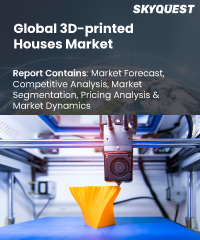
Report ID: SQMIG20G2034

Report ID:
SQMIG20G2034 |
Region:
Global |
Published Date: February, 2024
Pages:
157
|
Tables:
64 |
Figures:
75
3D-printed Houses Market size was valued at USD 0 Million in 2023 and is poised to grow from USD 0 Million in 2024 to USD 0 Million by 2032, growing at a CAGR of 61.5% during the forecast period (2025-2032).
The advantages of 3D-printed houses include the ability to construct a house quickly and with fewer resources, which can reduce the cost of construction and make homes more affordable. The technology also allows for more customization and design flexibility, as 3D printers can create complex shapes and curves that may be difficult to achieve with traditional construction methods. Additionally, 3D-printed houses can be built with materials that are more sustainable and environmentally friendly, which can help reduce the environmental impact of construction. While 3D-printed houses are a relatively new technology, they have been gaining traction in recent years as the technology has become more advanced and cost-effective. As the demand for affordable, sustainable, and customizable housing continues to grow, 3D-printed houses are likely to become an increasingly popular option for home construction.
Global 3D-printed Houses Market is a nascent market that is still in its early stages of development. However, it has shown significant potential in recent years, driven by advancements in 3D printing technology, increased adoption of sustainable construction practices, and a growing demand for affordable housing solutions. One of the key drivers of the 3D-printed houses market is the ability of 3D printing technology to reduce construction time and costs. With 3D printing, houses can be built in a matter of days, compared to traditional construction methods that can take months or even years. This not only saves time but also reduces labor costs and minimizes waste, making it an attractive option for developers and investors. Another significant advantage of 3D-printed houses is their sustainability. Many 3D-printed houses are built using eco-friendly and recyclable materials, making them a more environmentally friendly alternative to traditional construction methods. However, the market still faces some challenges, including the lack of building codes and regulations, high initial costs, and limited adoption of 3D printing technology in the construction industry. In addition, the market is currently concentrated in a few regions, mainly North America and Europe, with limited penetration in developing countries. Despite these challenges, the global market is expected to grow significantly in the coming years. This growth is likely to be driven by factors such as increased investment in research and development, greater adoption of 3D printing technology, and growing demand for affordable housing solutions in emerging markets.
US 3D-printed Houses Market is poised to grow at a sustainable CAGR for the next forecast year.
Our industry expert will work with you to provide you with customized data in a short amount of time.
REQUEST FREE CUSTOMIZATIONWant to customize this report? This report can be personalized according to your needs. Our analysts and industry experts will work directly with you to understand your requirements and provide you with customized data in a short amount of time. We offer $1000 worth of FREE customization at the time of purchase.

Report ID: SQMIG20G2034